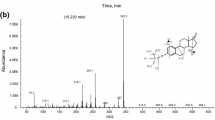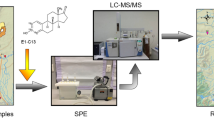Abstract
In this study, a method for the simultaneous determination of two steroid hormones, 17β-estradiol (E2) and estriol (E3), and a hormone mimicking polycarbonate, bisphenol-A (BPA), was developed and validated. This was thereafter used for the determination of the levels of the hormones in surface water collected around some livestock farms. The sensitivity of the method allowed the LODs and LOQs of the hormones and mimic hormone in the range 1.14–2.510 and 3.42–7.53 μg/L, respectively. The results revealed wide variability in the concentrations of E2 and E3, while BPA was not detected at any of the sampling stations. The concentration of E3 ranged between <1.14 and 45.5 μg/L (N = 120) in station 2 water. The highest concentration of E2 (15.7 μg/L, N = 80) was observed in water from station 1. The varied concentrations may be connected with the nature and sources of release, inconsistencies in analyte distribution due to dynamics of water flow pattern and the physical/chemical properties of the receiving water bodies.


Similar content being viewed by others
References
Aneck-Hahn, N. H., de Jager, C., Bornman, M. S., & du Toit (D. (2005). Oestrogenic activity using a recombinant yeast screen assay (RCBA) in South African laboratory water sources. Water SA, 31(2), 253–256.
Aneck-Hahn, N. H., Schulenburg, G. W., Bornman, M. S., Farias, P., & De Jager, C. (2007). Impaired semen quality associated with environmental DDT exposure in young men living in a malaria area in the Limpopo Province, South Africa. Journal of Andrology, 28, 423–434.
Aneck-Hahn, N. H., Bornman, M. S., & de Jager, C. (2008). Preliminary assessment of oestrogenic activity in water sources in Rietvlei Nature Reserve, Gauteng, South Africa. Article in African Journal of Aquatic Science, 33(3), 249–254.
Aneck-Hahn, N. H., Bornman, M. S., & de Jager, C. (2009). Oestrogenic activity in drinking waters from a rural area in the Waterberg District, Limpopo Province, South Africa. Water SA, 35(3), 245–251.
Arditsoglou, A., & Voutsa, D. (2008). Determination of phenolic and steroid endocrine disrupting compounds in environmental matrices. Environmental Science and Pollution Research, 15(3), 228–236.
Aufartova, J., Mahugo-Santana, C., Sosa-Ferrera, Z., Santana-Rodriguez, J. J., Novakova, L., & Solich, P. (2011). Determination of steroid hormones in biological and environmental samples using green microextraction techniques: an overview. Analytica Chimica Acta, 701, 33–46.
Borjesson, S. (2009). Antibiotic resistance in water: methicillin-resistant Staphylococcus aureus (MRSA) and antibiotics resistance genes. A dissertation (No 1128) submitted to the Division of Medical Microbiology, Department of Clinical and Experimental Medicine, Faculty of Health Sciences, Linkoping University, SE-581 85 Linkoping Sweden.
Boxall, A. B. A., Fogg, L. A., Kay, P., Blackwell, P. A., Pemberton, E. J., & Croxford, A. (2003a). Prioritisation of veterinary medicines in the UK environment. Toxicology Letters, 142, 399–409.
Boxall, A. B. A., Kolpin, D. W., Halling-Sorensen, B., & Tolls, J. (2003b). Are veterinary medicines causing environmental risks? Environmental Science & Technology, 37, 286A–294A.
Buser, H. R., Poiger, T., & Muller, M. D. (1999). Occurrence and environmental behavior of the chiral pharmaceutical drug ibuprofen in surface waters and in wastewater. Environmental Science & Technology, 33(15), 2529–2535.
Caminada, D., Escher, C., & Fent, K. (2006). Cytotoxicity of pharmaceuticals found in aquatic systems: Comparison of PLHC-1 and RTG-2 fish cell lines. Aquatic Toxicology, 79, 114–123.
Daughton, C. G. (2001). Emerging pollutants and communicating the science of environmental chemistry and mass spectrometry: Pharm. Environ. , 12(10):1067–1076.
Daughton, C. G., & Ternes, T. A. (1999). Pharmaceuticals and personal care products in the environment: agents of subtle change? Environmental Health Perspectives, 107(6), 907–938.
Diaz-Cruz, M. S., Alda, M. J. L., & Barcelo, D. (2003). Environmental behaviour and analysis of veterinary and human drugs in soil, sediments and sludge. Trends in Analytical Chemistry, 22, 340–351.
Díaz-Cruz, M. S., García-Galán, M. J., Guerra, P., Jelic, A., Postigo, C., Eljarrat, E., Farré, M., López de Alda, M. J., Petrovic, M., Petrovic, M., & Barceló, D. (2009). Analysis of selected emerging contaminants in sewage sludge. Trend in Analytical Chemistry, 28, 1263–1275.
ECHA (European Chemicals Agency) (2016). Guidance on information requirements and chemical safety assessment chapter R.7b: endpoint specific guidance. Reference: ECHA-16-G-02-EN ISBN: 978-92-9247-774-5 Publication date: February 2016 Language: EN © European Chemicals Agency, 2016. Accessed from https://comments.echa.europa.eu/comments_cms/FeedbackGuidance.aspx.
Goel, V. K., Lazar, A. J., Warneke, C. L., Redston, M. S., & Haluska, F. G. (2006). Examination of mutations in BRAF, NRAS, and PTEN in primary cutaneous melanoma. The Journal of Investigative Dermatology, 126, 154–160.
Halling-Sorensen, B., Sengelov, G., & Tjornelund, J. (2002). Toxicity of tetracyclines and tetracycline degradation products to environmentally relevant bacteria, including selected tetracycline-resistant bacteria. Archives of Environmental Contamination and Toxicology, 42, 263–271.
Heberer, T., Reddersen, K., & Mechlinski, A. (2002). From municipal sewage to drinking water: fate and removal of pharmaceutical residues in the aquatic environment in urban areas. Water Science and Technology, 46(3), 81–88.
Jafari, A. J., Pourkabireh, A. R., & Salehzadeh, A. (2009). Endocrine disrupting contaminants in water resources and sewage in Hamadan City of Iran. Iran Journal of Environmental Health Science and Engineering, 6(2), 89–96.
Jobling, S., & Sumpter, J. P. (1993). Detergent components in sewage effluent are weakly oestrogenic to fish: an in vitro study using rainbow trout (Oncorhynchus my kiss) hepatocytes. Aquatic Toxicology, 27, 361–372.
Kolpin, D. W., Furlong, E. T., Meyer, M. T., Thurman, E. M., Zaugg, S. D., Barber, L. B., & Buxton, H. T. (2002). Pharmaceuticals, hormones, and other organic wastewater contaminants in U.S. streams, 1999-2000: a national reconnaissance. Environmental Science & Technology, 36(6), 1202–1211.
Kummerer, K. (2010). Pharmaceutical in the environment. Annual Review Environmental and Resources, 35(1), 57–75.
Mahomed, S. I., Voyi, K. V. V., Aneck-Hahn, N. H., de Jager, C. (2008). Oestrogenicity and chemical target analysis of water from small-sized industries in Pretoria, South Africa. Available on website http://www.wrc.org.za ISSN 0378-4738 = Water SA Vol. 34 No. 3: 357–363.
Pojona, G., Gomiero, A., Lookers, N., & Marcomini, A. (2007). Natural and synthetic endocrine disrupting compounds (EDCS) in water, sediments and biota of a coastal lagoon. Environmental Internatational, 33(7), 929–936.
Roig, B., Touraud, E., (Eds) 2010. Pharmaceuticals in the environment; current knowledge and need for assessment to reduce impact. IWA Publishing, Alliance House, LONDON sw1h 0Qs, UK.
Sagar, S. S., Chavan, R. P., Patil, C. L., Shinde, D. N., & Kekane, S. S. (2015). Physico-chemical parameters for testing of water—a review. International Journal of Chemical Study, 3(4), 24–28.
SCC, (Stockholm Country Council) (2009). Environmentally classified pharmaceuticals. Stockholm Country Council’s Environmental Initiative. Accessed from: www.janusinfo.se/environment on 25th August, 2015.
Swart, N., & Pool, E. (2007). Rapid detection of selected steroid hormones from sewage effluents using an ELISA in the Kuils River water catchment area, South Africa. Journal of Immunoassay & Immunochemistry, 28(4), 395–408.
Ternes, T. A. (1998). Occurrence of drugs in German sewage treatment plants and rivers. Wat. Res., 32(11), 3245–3260.
Vandenberg, L. N., Colborn, T., Hayes, T. B., Heindel, J. J., Jacobs Jr., D. R., Duk-Hee, L., Shioda, T., Soto, A. M., vom Saal, F. S., Welshons, W. V., Zoeller, R. T., & John Myers, P. (2012). Hormones and endocrine-disrupting chemicals: low-dose effects and non-monotonic dose responses. Endocrine Reviews, 33(3), 378–455.
Vega-Morales, T., Sosa-Ferrera, Z., & Santana-Rodríguez, J. J. (2013). Evaluation of the presence of endocrine disrupting compounds in dissolved and solid wastewater treatment plant samples of gran Canaria Island (Spain). BioMed Research International, 790570, 1–16.
Waring, R. H., & Harris, R. M. (2005). Endocrine disrupters: a human risk? Molecular and Cellular Endocrinology, 244(1–2), 2–9.
Wieben, C.M., Baker, R.J., & Nicholson, R.S. (2013). Nutrient concentrations in surface water and groundwater, and nitrate source identification using stable isotope analysis, in the Barnegat Bay-Little Egg Harbor watershed, New Jersey, 2010–11: U.S. Geological Survey Scientific Investigations Report 2012–5287, 44 p.
Wilga, J., Kot-Wasik, A., & Namiesnik, J. (2008). Studies of human and veterinary drugs’ fate in environmental solid samples—analytical problems. Journal of Chromatographic Science, 46, 601–608.
Author information
Authors and Affiliations
Corresponding author
Rights and permissions
About this article
Cite this article
Olatunji, O.S., Fatoki, O.S., Opeolu, B.O. et al. Determination of selected steroid hormones in some surface water around animal farms in Cape Town using HPLC-DAD. Environ Monit Assess 189, 363 (2017). https://doi.org/10.1007/s10661-017-6070-8
Received:
Accepted:
Published:
DOI: https://doi.org/10.1007/s10661-017-6070-8




